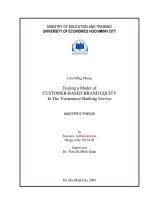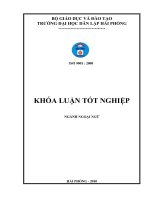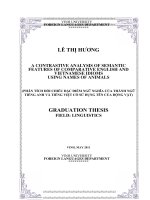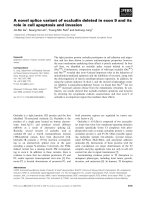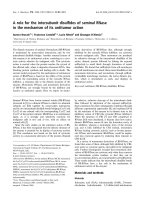A retrospective data examination of customer loyalty in the e banking technology services industry strategies for new successes
Bạn đang xem bản rút gọn của tài liệu. Xem và tải ngay bản đầy đủ của tài liệu tại đây (684.15 KB, 193 trang )
A RETROSPECTIVE DATA EXAMINATION OF CUSTOMER LOYALTY IN
THE E-BANKING TECHNOLOGY SERVICES INDUSTRY: STRATEGIES FOR
NEW SUCCESSES
by
John Reynolds
RICHARD MURPHY, DBA., Faculty Mentor and Chair
TONI B. GREIF, Ph.D., Committee Member
ROBERT A. KRAMARCZUK, Ph.D., Committee Member
Kurt Linberg, Ph.D., Dean, School of Business & Technology
A Dissertation Presented in Partial Fulfillment
Of the Requirements for the Degree
Doctor of Philosophy
Capella University
November 2007
UMI Number: 3288714
3288714
2008
Copyright 2007 by
Reynolds, John
UMI Microform
Copyright
All rights reserved. This microform edition is protected against
unauthorized copying under Title 17, United States Code.
ProQuest Information and Learning Company
300 North Zeeb Road
P.O. Box 1346
Ann Arbor, MI 48106-1346
All rights reserved.
by ProQuest Information and Learning Company.
© John Reynolds, 2007
Abstract
This study retrospectively examined 2006 e-banking technology services industry
customer loyalty survey data results in order to improve marketing resource allocation for
corporate e-banking products and services. Primary customers were delineated by bank
size (i.e., small, medium, and large) and single versus multi product purchases.
MANOVA and independent t test statistical measures were applied to 684 survey reports
gathered in 2006. The results indicated that statistically significant and lower ratings of
loyalty existed among the small and single product banks. Quality ratings were
differentiated between five subcategories (i.e., quality, trust, willingness to renew,
willingness to recommend, and willingness to expand). Trust, willingness to recommend,
and willingness to expand subcategories of quality were also rated significantly lower
among the small and single product banks compared with medium and large multi
product banks. Additional quality categories of general quality and willingness to renew
were not statistically significant between the various bank delineations. These results
provide the basis from which to complete additional research and begin the process of
making changes in resource allocation related to optimizing e-banking customer centric
business strategies.
iii
Dedication
This dissertation is dedicated to my family, who gave me the foundation to value learning
and the knowledge that learning never stops. To my wife and children who have given
me support and understanding over the past seven years. To my mother and father who
have always been an inspiration.
iv
Acknowledgments
I would like to thank my committee for their support and guidance especially Dr.
Toni Greif, Dr. Robert Kramarczuk, and my mentor Dr. Richard Murphy.
v
Table of Contents
Acknowledgments iv
List of Tables viii
List of Figures x
CHAPTER 1. INTRODUCTION 1
Introduction to the Problem 1
Background of the Study 4
Statement of the Problem 12
Purpose of the Study 13
Rationale/Significance 14
Research Questions 15
Hypotheses 16
Definition of Terms 17
Assumptions and Limitations 18
Theoretical/Conceptual Framework 20
Organization of the Remainder of the Study 25
CHAPTER 2. LITERATURE REVIEW 27
Introduction 27
Technology Advances and the New Economy 28
E-Business 35
Business Models and Theoretical Paradigms 47
vi
Organizational Structure and Leadership 55
Organizational Change and Trust 69
Customer Centric Business Strategy 82
Customer Loyalty 86
Summary 114
CHAPTER 3. METHODOLOGY 116
Introduction to the Methodology 116
Research Design 117
Population/Sample 119
Instrumentation 120
Data Collection Procedures 121
Statistical Analysis Procedures 122
Confidentiality/Ethical Issues 123
CHAPTER 4. DATA ANALYSIS 124
Introduction 124
Section One: Research Questions 125
Section Two: Hypothesis Testing 137
Summary 149
CHAPTER 5. RESULTS, CONCLUSIONS, RECOMMENDATIONS 150
Results 150
Conclusions 157
Recommendations 162
vii
REFERENCES 164
viii
List of Tables
Table 1. Research Design by Variable and Hypothesis. 117
Table 2. Average Loyalty Index Ratings by Bank Size 126
Table 3. Quality Dimension Ratings by Bank Size 129
Table 4. Trust Dimension Ratings by Bank Size 129
Table 5. Renew Dimension Ratings by Bank Size 130
Table 6. Recommend Dimension Ratings by Bank Size 130
Table 7. Expand Dimension Ratings by Bank Size 130
Table 8. Average Loyalty Index Ratings by Number of Products 132
Table 9. Quality Dimension Ratings by Number of Products 135
Table 10. Trust Dimension Ratings by Number of Products 135
Table 11. Renew Dimension Ratings by Number of Products 136
Table 12. Recommend Dimension Ratings by Number of Products 136
Table 13. Expand Dimension Ratings by Number of Products 136
Table 14. Small, Medium, Large Bank Loyalty Index Rating Differences 139
Table 15. Small, Medium, Large Bank Quality Dimension Rating Differences 140
Table 16. Small, Medium, Large Bank Trust Dimension Rating Differences 141
Table 17. Small, Medium, Large Bank Renew Dimension Rating Differences 142
Table 18. Small, Medium, Large Bank Recommend Dimension Rating Differences 143
Table 19. Small, Medium, Large Bank Expand Dimension Rating Differences 144
Table 20. Average Loyalty Index Rating Differences by Number of Products 145
ix
Table 21. Single vs. Multi product Quality Dimension Rating Differences 146
Table 22. Single vs. Multi product Trust Dimension Rating Differences 146
Table 23. Single vs. Multi product Renew Dimension Rating Differences 147
Table 24. Single vs. Multi product Recommend Dimension Rating Differences 148
Table 25. Single vs. Multi product Recommend Expand Rating Differences 148
x
List of Figures
Figure 1. Conceptual e-banking model 22
Figure 2. Sample participant percentage by bank size 126
Figure 3. Average loyalty index rating by bank size 127
Figure 4. Average quality dimension ratings by bank size 131
Figure 5. Sample participant percentage by number of products 132
Figure 6. Average loyalty index rating by number of products 133
Figure 7. Average quality dimension ratings by number of products 137
CHAPTER 1. INTRODUCTION
Introduction to the Problem
Treacy and Wiersema (1995) advocated for three different approaches or
philosophies that firms may adopt in order to deliver superior value to customers: (a)
operational excellence, (b) customer intimacy, or (c) product leadership. The most
challenging of the aforementioned value disciplines is based on the idea of customer
intimacy (i.e., being able to deliver to customers exactly what they want) (Treacy &
Wiersema, 1993).
The distinction between perceived service quality and customer satisfaction is
blurred in the marketing research literature (Anderson, 1998; Berry, Parasuraman, &
Zeithaml, 1994; Berry, Zeithaml, & Parasuraman, 1990; Cooil, Keiningham, Aksoy, Hsu,
2007; Cronin & Taylor, 1992; De Ruyter, Wetzels, Bloemer, 1998; Mueter, Ostrom,
Roundtree, & Bitner, 2000; Samuelsen, Gronseth, & Sandvik, 1997). However, customer
satisfaction and service quality are defined collectively as the ultimate goal for a firm is
customer retention or customer loyalty. Customer loyalty is the willingness of customers
to repurchase from a particular firm. However, empirical research makes no attempt to
distinguish between the concepts of perceived service quality, customer satisfaction, and
customer loyalty.
Customer loyalty, measured by intent to continue purchases, increase purchases
and recommend the company, is a good indicator of company profits. The study is based
on a theoretical basis where by moderating roles of switching cost, customer bonds,
2
perceived alternatives, and several demographical variables result in customer loyalty
ratings, but not necessarily satisfaction. Marketers have been interested in using these
moderating variables to develop effective marketing strategies to attract and retain the
most valuable customers. Furthermore, according to Berry, Parasuraman, and Zeithaml
(1994), customers perceive some attributes more important than others when determining
the overall service quality and satisfaction. As such, service quality attributes should be
measured routinely to provide actionable managerial guidance regarding which service
areas a firm should concentrate on in efforts to build loyalty among current customers
and attract profitable prospects (Berry, Zeithaml, & Parasuraman, 1990).
Customer satisfaction is associated with an overall performance of the-banking
relationship that customers experience through repeated transactions with the bank. As
described above, customer satisfaction is determined by two primary indicators: (a)
expectations or comparison standards, and (b) performance perception.
In order to achieve loyal customers, banks must know how to satisfy the
customers. Thus, focus on the customers must be given highest priority in on-line-
banking. However, a critical issue follows in regard to how banks can remain in control
of customers' access to the distribution channels. In the physical marketplace, banks have
dedicated links to their customers through their branch network. In electronic markets,
services are mediated through a distribution channel with several intermediaries
participating in the value chain: context providers, network operators, Internet access
providers, business service providers (i.e., portals) and, to an increasing extent, brokers
and (i.e., software) agents. From having a dedicated link to their customers through
3
branches, banks are pushed backwards in the value chain with the danger of losing
control of customer access. Disintermediation and loss of customer control mean reduced
opportunities for fostering customer satisfaction and building strong brands. To achieve
this control, it is predicted that cooperation with new actors in the value chain will be
needed. This may also be supplemented by focused acquisitions and licensing of software
products (Gordon, 1996).
To satisfy customers, it is important to listen to the individual and specific needs
and desires (Sterne, 1998). Therefore, it is of vital importance to give customers the
opportunity to respond to offers. Responding can include questions, comments on
services, suggestions for improvements, demands, etc. and can be mediated through the
e-mail system. Another way to satisfy customers is to personalize services. Loyal
customers can be obtained by providing them with personal attention (Allen, Kania, &
Yaeckel, 1998). Frequently asked questions (FAQ), organized discussion groups and the
use of push technology to move personalized messages to customers are other means by
which added value for the customers can be created. Value-added services are assumed to
make customers more satisfied.
Branding and brand reputation have been discussed in the marketing literature
over the last 10 years (Aaker, 1996; Edlin, & Harkin, 2003; Keating, 2006; Mitchell,
2000; Samuelsen et al., 1997). According to Samuelsen et al. (1997) reputation is an
important determinant of loyalty when products are difficult to evaluate. In markets with
many suppliers, complex services and unclear values and preferences, rational choices
are difficult to make. Mechanisms to simplify buying decisions are needed. Brand
4
reputation is one such mechanism where information gathering and processing are
reduced by substituting attribute evaluation with heuristics (i.e., the brand).
To explain why customer satisfaction seems to be a stronger determinant of
loyalty than brand reputation, the research will need to look at the bank services currently
available from most of the competing institutional trust/Internet banks. Brand reputation
is thought of as being a strong determinant of loyalty in markets with complex products
where simplifying buying decisions is needed. The bank services available to the
customers in the study may be perceived as standardized services, although with rather
complex cost structures (e.g., transaction fees, asset based charges, etc.).
Background of the Study
Technology and the Internet have had a profound effect on service marketing
(Bitner, Brown, & Mueter, 2000). DeRuyter, Wetzels, and Kleijnen (2001) argued that
the next vista for organizations operating in virtual marketplaces will involve e-service,
which they defined as "an interactive, content-centered and Internet -based customer
service, driven by the customer and integrated with related organizational customer
support processes and technologies with the goal of strengthening the customer-service
provider relationship" (p. 186). Thus, e-service is viewed as an emerging mechanism for
achieving customer relationship management strategic outcomes. This study supports the
objectives of this issue by providing an exploratory test of traditional service/relationship
marketing theory and measures within the emerging e-banking industry.
5
Part of the attractiveness of e-banking for bank marketers is the ability to shift
some of the burden of after-sale service and support to end users via the Internet. Many
marketers hope to eventually replace traditional mechanisms for after-sale service such as
large and expensive customer support/service call centers with digital forms of e-service
(e.g., e-mail support protocols, online chat, Frequently Asked Questions/FAQs, and
online knowledge bases). The mechanism for the transition to digital forms of e-service is
e-banking software that directly links an end user with a marketer's human support
resources and knowledge base. This orientation helps to make clear the linkages between
e-banking and relationship marketing. Banks today are increasingly providing customer
service in support of relationship marketing strategic objectives, with the help of
technology via e-service (Barnes, Dunne, & Glynn, 2000; Mueter, Ostrom, Roundtree, &
Bitner, 2000). E-banking software suites provide the mechanism by which companies
hope to begin to more efficiently and efficaciously provide such e-service at a lower cost.
It is hypothesized that the aforementioned customer service needs are particularly
important for the emerging e-banking industry as this industry must be able to support the
efficacy of their products and services in achieving relationship marketing strategic
objectives if e-service is to continue to grow as a viable marketing tactic. The
organizations within this industry can most effectively achieve this end by demonstrating
the ability to be exemplars of relationship marketing efficacy in their own marketing
relationships with the purchasers of e-banking software (i.e., products) and service.
6
Loyalty
Customer loyalty is a complex, aggregated concept that cannot be defined nor
measured by any single variable. From marketing literature, several antecedents of
loyalty have been revealed. Among the determinants of loyalty toward a brand is
customers’ satisfaction with the brand (Samuelsen, Gronseth, & Sandvik, 1997; Selnes,
1993), brand reputation (Samuelsen et al., 1997; Selnes, 1993), switching costs (Dick &
Basu, 1994), salesperson trust (Macintosh & Lockshin, 1997), salesperson commitment
(Macintosh & Lockshin, 1997), and affective antecedents such as emotion, feeling and
mood (Dick & Basu, 1994). Furthermore, social norms and situational influences are
assumed to affect loyalty (Dick & Basu, 1994). This research focuses on loyalty among
bank customers on the Internet. Such customers do not meet salespersons. Salesperson
trust and salesperson commitment are therefore excluded from the analysis. Furthermore,
the research excludes affective antecedents such as emotion, feeling and mood, assuming
that customer relationships are primarily based on cognitive evaluations of the bank due
to the nature of the services bought. Search costs are assumed to be reduced when
moving from the traditional marketplace to electronic markets (Bakos, 1991). Search
costs are also treated as a part of the switching cost construct (Fornell, 1992). Since
search costs are regarded as an important part of the economics of electronic markets,
search costs will be treated as an explicit determinant of loyalty.
Many definitions of loyalty have been presented in the literature. Jacoby and
Chesmut (1978) gave a summary of many of them to conclude that the only way to reveal
real loyalty is to measure customers’ attitudes and intensions toward the brand in
7
question. Based on this, loyalty is to measure customers' attitudes and intentions toward
the brand in question. Based on this, Oliver (1997) defined customers’ loyalty as “a
deeply held commitment to re-buy or re-patronize a preferred product or service
consistently in the future, despite situational influences and marketing efforts having the
potential to cause switching behavior” (p. 392). This means that customers must perceive
the bank as better than competitors (i.e., affective loyalty). Re-buying or re-patronizing
means that customers must have an intention to keep on using the bank in the future (i.e.,
conative loyalty). In other words, affective loyalty is related to customers' attitudes
toward the bank while conative loyalty is related to customers' behavioral intentions
toward the bank in the future. Based on this, we see that loyalty is not only re-buying, or
what Dick and Basu (1994) called spurious loyalty, but loyalty toward a brand also
implies a positive attitude toward the brand in addition to intention to re-buy the brand.
Moving from the traditional face to face marketplace to an electronic marketplace,
changes customer relationships. It is therefore assumed that some of the determinants of
loyalty will be affected. A reduction in search costs has been predicted (Bakos, 1991,
1997; Strader & Shaw, 1997). This reduction is assumed to reduce loyalty and it may also
be argued that it will change the effect of search costs on loyalty relative to other
determinants. Brand reputation is often used as a heuristic for the evaluation of a brand. If
a brand has a positive reputation, customers are supposed to be loyal to the brand.
Furthermore, better opportunities in searching for information about a brand in electronic
markets make it easier for customers to evaluate brand attributes before they buy. This
reduces the importance of brand reputation as a heuristic for brand quality. A
8
consequence of this could be that the relative importance of brand reputation on loyalty is
reduced. Electronic markets also enable a wide range of new seller and customer
relationships to be set up, for instance increased and customized product information,
customer participation in product development and reduction in order fulfillment time
(Methlie, 1998). All this may improve customer satisfaction (Strader & Shaw, 1997). By
increasing customer satisfaction, this variable may increase its importance as a
determinant of loyalty. Based on these possible changes, a fair proposition is that the
values of the determinants of loyalty will change when moving bank services from the
physical marketplace to an electronic market.
Affective and Conative Loyalty
Affective loyalty is a component of loyalty that focuses on how much a customer
likes the bank or how positive their attitude is toward the bank. Conative loyalty focuses
on the customer's intention to keep on using the bank in the future. Fishbein and Ajzen
(1975) argued that attitude toward a product predicts attitude toward buying the product.
Attitude toward buying the product is assumed to predict intention to buy the product. In
marketing literature, attitude toward a product is often used as a direct predictor of
intention to buy the product (Brown & Stayman, 1992; Homer, 1990). Since customer
satisfaction and brand reputation are the main determinants of loyalty, banks on the
Internet should struggle to satisfy their customers and build strong brands.
From research in marketing, there is some knowledge about the determinants of
loyalty in the physical marketplace. Taking this knowledge as the basis, this research is
based on the investigation of whether determinants of loyalty in the marketplace hold in
9
electronic markets as well. The research therefore delineates between various
determinants of loyalty which include customer satisfaction with a brand, brand
reputation, switching costs, and search costs.
Satisfaction
Customer satisfaction is a post-choice evaluation of a specific transaction (Selnes,
1993). Early studies conceptualized customer satisfaction as customer perception of
product performance (Anderson, 1973; Cardozo, 1965). Later studies showed that
customer satisfaction is a function of customer perception of product performance
compared to a set of standards (e.g., expectations, values and norms) related to the
confirmation/disconfirmation paradigm (Yi, 1990). In addition to the direct effect of
confirmation/disconfirmation, both expectation (i.e., the comparison standard) and
perception of brand performance are found to have direct effects on customer satisfaction
with a brand (Churchill & Surprenant, 1982; Yi, 1990).
Satisfaction is considered to act as an antecedent of loyalty, arising out of direct
prior experience (Dick & Basu, 1994). Several studies have found support for the positive
relationship between customer satisfaction with a brand and their loyalty toward that
brand (Fornell, 1992; Samuelsen et al., 1997; Sandvik & Duhan, 1996). “Loyal customers
are not necessarily satisfied customers, but satisfied customers tend to be loyal
customers” (Fornell, 1992, p. 7). A satisfied customer has few incentives to change
supplier or brand. Therefore, “customer satisfaction makes it costly for a competitor to
take away another firm's customer” (Fornell, 1992, p. 10). Satisfying customers should
therefore be of great importance to vendors in keeping their customers loyal. Customers
10
who are satisfied with their bank probably develop a positive attitude toward the bank. As
a result, their intention to stay with the bank in the future is likely to be high.
Brand Reputation
A brand is a name, term, symbol, sign or design to identify the goods or services
of one seller and to differentiate them from those of competitors (Keller, 1998). Brand
reputation has been defined as a perception of quality associated with the brand's name
(Selnes, 1993). A strong brand is a brand with “a set of assets linked to a brand's name or
symbol that adds to the value provided by a product or service to that firm's customers”
(Aaker, 1996, p. 7-8). A strong brand is a signal of quality; it is a risk reducer for
customers and it reduces search costs (Keller, 1998). A brand name, or a brand’s
reputation, is often used as a heuristic for choice when intrinsic cues or attributes are
difficult or impossible to employ (Selnes, 1993). Brand reputation and satisfaction may
look like the same construct. In the literature, however, brand reputation is seen more as a
long-term and overall evaluation of the product than customer satisfaction (Selnes, 1993).
A positive relationship is expected between brand reputation and customer loyalty
to the brand (Sandvik & Duhan, 1996). The reason for this is that a brand's reputation
might function as a social norm and that customers often rely on the beliefs of their
reference groups to a great extent. Another reason why brand reputation is important for
loyalty is that it may be difficult to evaluate satisfaction with a product directly in some
situations. In such situations, the brand reputation is used as a heuristic for evaluating the
product. However, an important point to note is that customer satisfaction with a brand is
a determinant of brand reputation in some situations. In the insurance industry, for
11
instance, customer satisfaction with a brand is found to have a positive relation to brand
reputation (Selnes, 1993). This underscores both the direct and indirect effects of
customer satisfaction on customers' loyalty.
Switching Costs
Porter (1980) defined switching costs as the costs of switching from one supplier's
product to another supplier's product. Fornell (1992) included search costs, transaction
costs, learning costs, customers' habits, emotional costs and cognitive effort in the
switching costs construct. As can be seen, switching costs include both economic and
psychological values. Switching costs is a common strategy to increase loyalty (Dick &
Basu, 1994). Currently, banks are eager to launch loyalty programs where customers
obtain substantial benefits by holding most of their banking business within one bank
(positive lock-in).
“Switching barriers make it costly for the customer to switch to another supplier”
(Fornell, 1992, p. 10). The implication of this proposition is a positive relationship
between switching costs and customer loyalty. High switching costs retain customers
from changing banking relationships. Therefore, an increase in switching costs will lead
to an increase in loyalty. Since this is a kind of lock-in strategy, it has a positive effect on
the intention to keep on as a customer (i.e., conative loyalty), rather than on customers'
affective commitment toward the bank (i.e., affective loyalty). Anecdotal experience
suggests that customers will probably perceive high switching costs as something
negative, which reduces their flexibility to switch supplier or product.
12
Search Costs
Fornell (1992) included search costs as part of the switching costs construct. In
this research, search costs will be treated as a construct of their own since search costs are
an important aspect of the economics of electronic markets and a key concept in studying
buyers' behavior. A standard definition of buyers' search costs in the economic literature
is “the cost incurred by the buyer to locate an appropriate seller and purchase a product”
(Bakos, 1997, p. 1677). A major impact of electronic markets is that they reduce the costs
customers must pay to search for information about products in the market (Bakos,
1991).
High search costs are assumed to make it expensive for customers to shop around
for the best offer in the market. The implication of this is that it is costly for customers to
find alternative brands or suppliers. Therefore, they keep on using the same brand or the
same supplier. This implies that high search costs lead to high conative loyalty. However,
customers are probably not satisfied with a situation where it is difficult to find
alternatives and, thus, having limited flexibility being imposed on them.
Statement of the Problem
Given the proliferation in the 21
st
century of the e-banking industry, change is an
ongoing process which impacts customer loyalty and satisfaction. Currently, the e-
banking technology services industry customer loyalty survey is utilized as a valid and
reliable instrument from which to base organizational decisions related to e-banking. The
problem with current utilization of e-banking technology services industry customer
13
loyalty survey data for primary clientele of the company are not stratified by bank size or
single versus multi product services. With additional evaluation of survey results, e-
banking resource allocation can be more focused and efficacious in promoting corporate
profitability as compared with current utilization which primarily benefits quality
improvement programming.
Purpose of the Study
The purpose of this study was based on a retrospective examination of 2006 E-
banking technology services industry customer loyalty survey data results in order to
provide information for better marketing resource allocation and corporate success in the
e-banking product and service industry. The most significant relationships among service
quality dimensions, perceived value, customer satisfaction, and customer loyalty are
assessed by primary customer (i.e., bank) size and single versus multi product delineation
which is currently not analyzed by corporate executives. This study utilized quantitative
ex post facto data examination methods to stratify the primary e-banking clientele survey
results to be used for improved resource allocation, particularly marketing. MANOVA
(i.e., multiple analyses of variance) statistical measures will identify the most significant
e-banking clientele loyalty ratings by size stratification (i.e., small, medium, large asset
classes) and single versus multi product classification. Customer loyalty, measured by
intent to continue purchases, increase purchases, and recommend the company is a good
indicator of company profits (Gounaris & Stathakopoulos, 2004).

